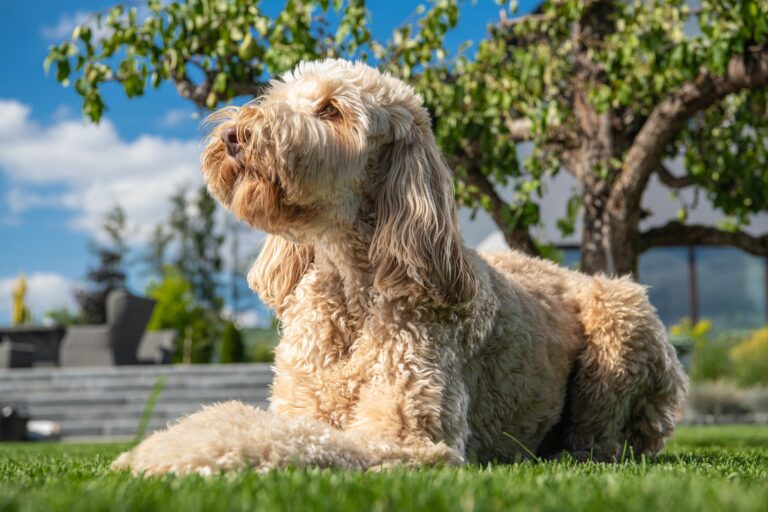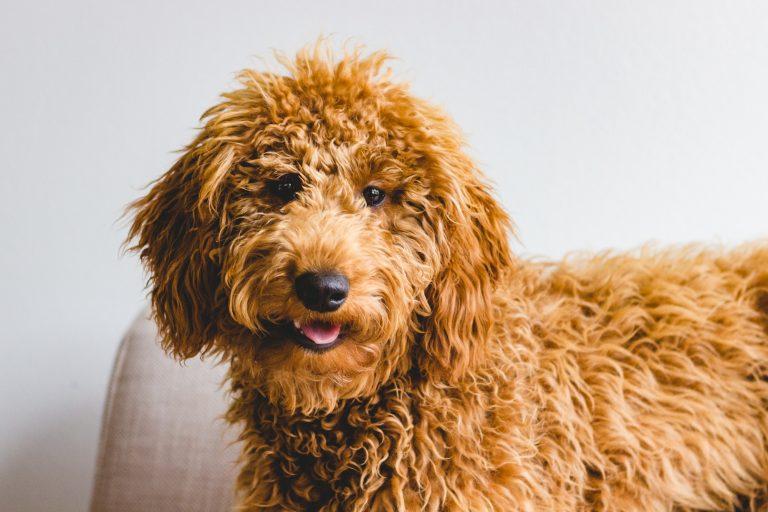Labradoodle: Most Pawsome Designer Dog
Are you curious about the Labradoodle, the designer dog that started the doodle craze? As the name suggests, this breed is a mix between a Labrador Retriever and a Poodle, resulting in a dog that combines the best traits of both breeds.
What is a Labradoodle Designer Dog Breed?
The Labradoodle is not an actual breed but a mixed breed dog intentionally bred to exhibit desirable traits of their foundation breeds. The term “designer dog breed” refers to intentionally breeding two different purebred dog breeds to create a new breed that hopefully exhibits the best traits of both.
History of the Labradoodle Designer Dog Breed

The Labradoodle is a mixed breed dog, created by crossing a Labrador Retriever and a Standard Poodle. The breed was first developed in Australia in the late 1980s by Wally Conron, a breeder from the Royal Guide Dog Association of Australia. The Labradoodle was created to produce a hypoallergenic guide dog suitable for people with allergies.
The Labradoodle gained popularity in Australia and quickly spread to other countries, including the United States. Labradoodles were used in the entertainment industry in the U.S. as early as the 1960s, with a Labrador-Poodle mix named Fang having a recurring role on the Get Smart show starting in 1965. However, the breed did not gain widespread popularity until the 1990s.
Today, Labradoodles are recognized as a hybrid or designer breed by some breed organizations but not by significant kennel clubs such as the American Kennel Club (AKC). However, Labradoodles remain popular due to their friendly personalities, intelligence, and hypoallergenic coats.
Characteristics of the Labradoodle
Labradoodles are known for their friendly and social temperament, making them great family dogs. They also have a non-shedding coat, which makes them a good choice for people with allergies. The size and appearance of Labradoodles can vary depending on the parent breeds and the specific breeding process. Labradoodles can be miniature, medium, or standard-sized, and their coat can be curly, wavy, or straight.
Size of Labradoodle
The size of a Labradoodle can vary based on several factors, including the size of the parent dogs and the generation of the Labradoodle. Here are some of the factors that can affect the size of a Labradoodle:
-
Parent dogs: The size of the parent dogs is one of the most significant factors that can affect the size of a Labradoodle. If a Standard Poodle is bred with a Labrador Retriever, the resulting Labradoodle may be larger than if a Miniature Poodle is bred with a Labrador Retriever.
-
Generation: The generation of a Labradoodle can also affect its size. First-generation Labradoodles, bred from a Labrador Retriever and a Standard Poodle, may be larger than later generations. Multi-generation Labradoodles, bred from Labradoodles and other Labradoodles, may be smaller.
-
Health: The health of a Labradoodle can also play a role in its size. If a Labradoodle is unhealthy or has a medical condition, it may be smaller than a healthy Labradoodle of the same age.
Labradoodles come in three sizes: miniature, medium, and standard. The size of a miniature Labradoodle can range from 15 to 25 pounds, while the size of a medium Labradoodle can range from 50 to 65 pounds. The standard Labradoodle can range from 21 to 24 inches in height and weigh between 50 and 90 pounds.
Health Concerns

While they are generally healthy dogs, they can be prone to certain health conditions that affect both parent breeds.
Congenital eye issues: Labradors and Poodles can be prone to certain eye conditions such as cataracts, progressive retinal atrophy, and glaucoma. Labradoodles can inherit these conditions, making it important for breeders to screen their dogs for these issues before breeding.
Hip Dysplasia: Hip dysplasia is a common orthopedic condition in dogs, affecting Labradors and Poodles. A hip joint malformation causes this condition and can lead to arthritis and lameness. Responsible breeders will screen their dogs for hip dysplasia and only breed dogs with healthy hips.
Heart Disease: Both Labradors and Poodles can be prone to certain types of heart disease, such as mitral valve disease and dilated cardiomyopathy. Labradoodles can inherit these conditions, so breeders need to screen their dogs for heart disease and only breed dogs with healthy hearts.
Other health concerns affecting Labradoodles include allergies, ear infections, and dental disease. Regular veterinary check-ups and preventative care can help keep Labradoodles healthy and catch any health issues early.
In conclusion, Labradoodles can be prone to certain health conditions that affect both parent breeds. Responsible breeding practices, regular veterinary care, and preventative measures can help keep Labradoodles healthy and happy for years.
Adopt a Labradoodle
Adopting a Labradoodle can be a rewarding experience, but it’s essential to do so with the right motives and expectations. Here are some things to consider when adopting a Labradoodle:
-
Research: Before adopting a Labradoodle, research the breed’s characteristics, temperament, and grooming requirements. This will help you determine if a Labradoodle is the right fit for your lifestyle and family.
-
Adopt from a reputable source: Adopt from a reputable rescue organization or breeder who prioritizes the health and well-being of their dogs. Avoid purchasing from puppy mills or pet stores.
-
Understand the commitment: Adopting a Labradoodle is a long-term commitment. They require regular exercise, training, and grooming to keep them healthy and happy.
-
Consider the dog’s history: Many Labradoodles in rescue shelters have been through traumatic experiences, so it’s important to approach adoption with patience and understanding. Work with a rescue organization that can provide you with information about the dog’s history and any special needs they may have.
-
Be prepared for imperfection: No dog is perfect, and rescue Labradoodles may have behavioral or health issues that require extra attention and care. Be prepared to provide the necessary care and training to help your Labradoodle become a wonderful companion.
Adopting a Labradoodle can be a fulfilling experience, but it requires the right research and preparation. By researching, adopting from a reputable source, understanding the commitment, considering the dog’s history, and being prepared for imperfection, you can provide a loving home for a Labradoodle in need.
Labradoodle vs. Goldendoodle: Which is Better?
If you’re considering getting a doodle breed dog, you may wonder which is better: a Labradoodle or a Goldendoodle. Both breeds are mixed breed dogs created by crossing a Poodle with another breed, typically a Labrador Retriever or a Golden Retriever. Here are some factors to consider when deciding which breed is better for you:
Size and Energy Level: A Labradoodle may be a better choice if you’re looking for a large, more energetic dog for hunting or other working purposes. Labradoodles tend to be slightly larger and more energetic than Goldendoodles, which makes them a better choice for working or service dog work. However, if you’re looking for a dog with a lower energy level, a Goldendoodle may be a better fit.
Temperament: Both breeds are known for their friendly and outgoing personalities, but Goldendoodles are often chosen for therapy dog work due to their sunny and sociable dispositions. Labradoodles can also make great therapy dogs, but their slightly higher energy level may make them better suited for service dog work.
Coat: Both breeds have non-shedding coats, which makes them a popular choice for people with allergies. However, the coat of a Goldendoodle tends to be longer and wavier than a Labradoodle, which typically has a shorter, curlier coat. The longer coat of a Goldendoodle may require more grooming and maintenance than a Labradoodle’s coat.
The better choice between a Labradoodle and a Goldendoodle ultimately depends on your needs and preferences. Consider the size, energy level, temperament, and coat type when deciding which breed is right for you. Both breeds make excellent family pets and companions, so you can’t go wrong with either choice.
Conclusion
The Labradoodle is a unique and popular designer dog breed that has gained much attention recently. As a mixed breed dog intentionally bred to exhibit desirable traits of their foundation breeds, the Labradoodle combines the best traits of both the Poodle and the Labrador Retriever. Their non-shedding coat and friendly temperament make them an excellent choice for families, and their intelligence makes them easy to train. We hope this article has introduced you to the Labradoodle designer dog breed and answered some of your frequently asked questions.
Frequently Asked Questions
How much exercise does a Labradoodle need?
Labradoodles are active dogs and require regular exercise, such as daily walks and playtime. The amount of exercise needed can vary depending on the dog’s size and energy level.
Are Labradoodles hypoallergenic?
Labradoodles are often called hypoallergenic because they have a non-shedding coat. However, no dog breed is truly hypoallergenic, and some people with severe allergies may still react to Labradoodle.
Are Labradoodles easy to train?
Labradoodles are intelligent dogs and can be easily trained with positive reinforcement methods. However, like all dogs, their training requires patience and consistency.
Is a Labradoodle or Goldendoodle better?
If you’re looking for a working or hunting dog, a Labradoodle may be better because of its slightly bigger size and higher energy level. Labradoodles are often chosen for service dog work, too. However, Goldendoodles are very popular for therapy dog work thanks to their outgoing, sunny personalities.
Are Labradoodles High Maintenance?
Labradoodles have a high maintenance grooming requirement due to their thick, curly coats. They require regular brushing to prevent matting and tangling and professional grooming every few months to maintain their coat’s health and appearance.




